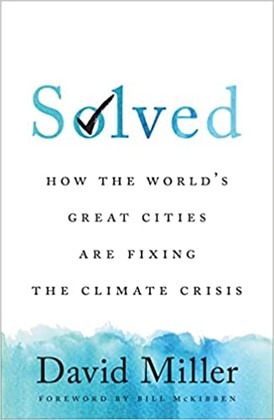Book Review - Solved: How the World’s Great Cities are Fixing the Climate Crisis

Solved: How the World’s Great Cities are Fixing the Climate Crisis by David Miller. Toronto: University of Toronto Press 2020. 208 pp., $34.99 hardcover 9781487506827
Where can we find bold and creative leadership on the crucial problems of our time? Increasingly, the answer is cities; and recently, their tool of choice is city networks. The list of city networks that tackle global problems includes Mayors for Peace (nuclear abolition), the WHO Global City Network (health emergencies), and the C40 Climate Leadership Group (climate change), to name just a few. These networks allow cities to share expertise and best practices, pool resources, and keep one another accountable for their actions. David Miller, the current Managing Director for the C40 Centre for City Climate Policy and Economy and the former Mayor of Toronto (2003-2010), has written a book that details how cities around the world (many of them members of C40) are working toward a cleaner, more sustainable future.
 There is an urgency throughout the book: the world temperature must be kept within 1.5 degrees Celsius above pre-industrial levels, or else the world will face catastrophic consequences. Humanity must act now, and cities are leading the way. One of the arguments of this book is that cities can effectively model positive climate actions for other cities and actors at other scales (such as states and companies). Miller writes, “By demonstrating that climate action works, city leadership can overcome the biggest challenges to solving the climate crisis: inertia and the perception that measures to address climate change make people’s lives more expensive, more difficult, or worse” (p. 15).
There is an urgency throughout the book: the world temperature must be kept within 1.5 degrees Celsius above pre-industrial levels, or else the world will face catastrophic consequences. Humanity must act now, and cities are leading the way. One of the arguments of this book is that cities can effectively model positive climate actions for other cities and actors at other scales (such as states and companies). Miller writes, “By demonstrating that climate action works, city leadership can overcome the biggest challenges to solving the climate crisis: inertia and the perception that measures to address climate change make people’s lives more expensive, more difficult, or worse” (p. 15).
The book offers insights and examples that cities can use immediately. Many of the examples within the book—such as the use of electric public vehicles, requiring buildings to be energy efficient, and the use of a bike share system—can be implemented by cities of any size. The book is divided into seven chapters, each based on a functional aspect of reducing / mitigating a city’s greenhouse gas emissions.
The first chapter, “Plans,” deals with how cities create plans of action to address climate change. The chapter describes how to make plans that decrease greenhouse gas emissions while also taking into consideration equality, prosperity, and health. A key point in this chapter is that the planning process should be transparent and done in dialogue with local citizens.
The second chapter, “Energy and Electricity,” describes how cities can make the switch to renewable energy sources now. A crucial idea in this chapter is that cities do not need to wait for dramatic technological innovations. They can use existing technologies to make a large-scale shift to renewable sources of energy. The third chapter, “Existing Buildings,” examines how regulations and retrofitting activities can make existing buildings more energy efficient. The chapter makes the case that retrofitting existing buildings may reduce greenhouse gas emissions by as much as 20-55 percent.
The fourth chapter, “New Buildings,” argues that the technology already exists to create energy efficient and even emissions-free buildings and homes. Cities can help the transition to energy efficient buildings through eco-friendly building codes and programs to encourage the construction industry to shift to energy-efficient buildings.
The fifth chapter, “Public Transportation,” makes the case that not only do cities need to expand public transportation, but they also need to do so in ways that are clean and energy efficient. Though the chapter offers many examples of how to make public transportation clean and efficient, the shift to buses is presented as one of the most effective methods. As Miller argues, there are very few technical impediments to the mass adoption of electric public buses and other vehicles for public transport.
The sixth chapter, “Personal and Other Transportation,” argues that the need for personal cars can be eliminated by making cities easier to walk and cycle. One solution presented in this chapter that almost any city can implement is the use of a bicycle sharing system. In addition, by offering charging ports, cities can help speed up the transition to electric cars and taxis.
The seventh chapter, “Waste,” examines the issue of waste management. A key point in this chapter is that cities should embrace a “circular” economy, where items are reused, and waste is avoided altogether. When waste is produced, efforts should be made to separate compostable waste and capture landfill gas. In the final chapter, “Epilogue,” Miller summarizes the progress that C40 cities have made so far and makes an impassioned call for readers to use their voices, actions, and votes to help the transition to a sustainable future.
One of the questions this book seeks to answer is this: When it comes to facing climate change, why should cities be considered essential actors? This “Why cities?” question is at the center of this book. One of Miller’s major arguments is that cities are closer to their citizens and more flexible as actors. Also, because cities are accountable for much of the greenhouse gas emissions responsible for climate change, they are also best situated to solve these problems. The book finds that when it comes to becoming green, many cities struggle with the same issues. Nevertheless, even in situations where one size doesn’t fit all, cities can still learn from one another.
The book also demonstrates the benefits of joining a city network to share expertise and help motivate citizens to reach ambitious goals. Much of the book’s lessons come from the collective knowledge of the C40 Climate Leadership Group, a network that is only open to big urban cities. However, the United Nations-backed global campaign Race to Zero is a program that has no population restrictions.
Though most of the examples for combating climate change in Solved emanate from big cities, that does not mean that small and medium-sized cities cannot learn from the book. Many of the solutions—such as the use of electric public transportation, ride-share systems, low emission zones, and the retrofitting of buildings—can be used by cities of any size. When it comes to combating climate change, the book maps a path that any city can take: create a plan, implement the plan, measure progress, revise the plan, and then repeat.
Daniel Clausen is a full-time lecturer at Nagasaki University of Foreign Studies. He is a graduate of Florida International University’s Ph.D. program in International Relations. His research interests vary widely from Japanese foreign policy to English language teaching. His research has been published in Asian Politics and Policy, e-International Relations, Electronic Journal of Contemporary Japanese Studies, The Diplomatic Courier, and Culture and Conflict Review, among other publications.


